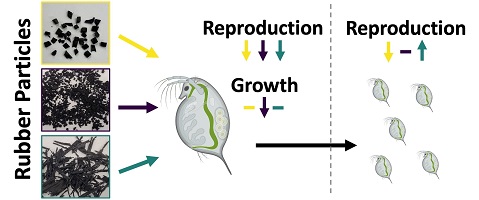Environmental context. Tyre rubber particles, from both driving and reuse of tyre rubber, are pollutants that carry toxic chemicals into the environment. We investigated the long-term effects that these particles have on small aquatic organisms and found that they drastically reduce their ability to reproduce. Continued exposure of aquatic invertebrates to tyre-related pollutants, has the potential to affect the population by inhibiting reproduction into future generations. (Image credit: Brittany Cunningham.)
This article belongs to the collection: Tyre road wear particles – chemistry and impacts.
EN23131 Abstract | EN23131 Full Text | EN23131PDF (1.3 MB) | EN23131Supplementary Material (1.1 MB) Open Access Article








